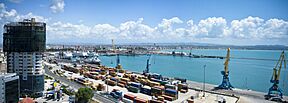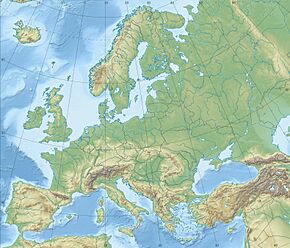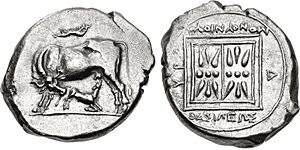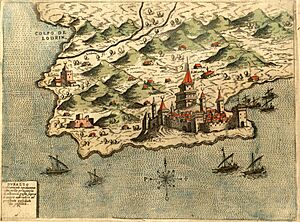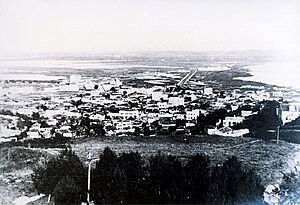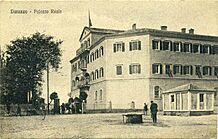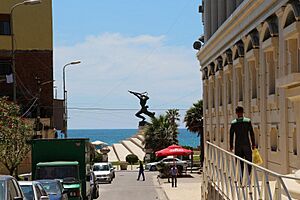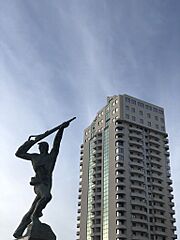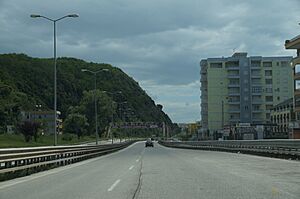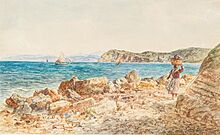Durrës facts for kids
Quick facts for kids
Durrës
|
|||
|---|---|---|---|
|
Municipality and city
|
|||
|
Panorama of Durrës
Mosaics at a Basilica within the Amphitheatre
Venetian Tower
Albanian College
Church of Saint Asti and Apostle Paul
Ancient walls
Amphitheatre
Iliria Square
|
|||
|
|||
| Country | Albania | ||
| Region | Northern Albania | ||
| County | Durrës | ||
| Founded | 7th century BC | ||
| Government | |||
| • Type | Mayor–council | ||
| • Body | Durrës Municipal Council | ||
| Area | |||
| • Municipality | 338.30 km2 (130.62 sq mi) | ||
| Elevation | 0 m (0 ft) | ||
| Population
(2011)
|
|||
| • Municipality | 175,110 | ||
| • Municipality density | 517/km2 (1,340/sq mi) | ||
| • Administrative unit | 113,249 | ||
| Demonym(s) | Albanian: Durrsak (m), Durrsake (f) | ||
| Time zone | UTC+01:00 (CET) | ||
| • Summer (DST) | UTC+02:00 (CEST) | ||
| Postal code |
2000
|
||
| Area code | +355 (0) 52 | ||
| Seaport | Port of Durrës | ||
| Motorways | |||
| Highways | |||
| Vehicle registration | DR | ||
Durrës is the second largest city in Albania. It is also the main city of Durrës County. Durrës is one of Albania's oldest cities, with a history of about 2,500 years. It is located on a flat plain by the Adriatic Sea, between the Erzen and Ishëm rivers. Durrës has a Mediterranean climate.
The city was founded by ancient Greek settlers from Corinth and Corcyra around 700 BC. They called it Epidamnos and worked with the local Illyrian people. Later, it was known as Dyrrachium and became a very important city in the Roman Empire and the Byzantine Empire. A famous Roman road, the Via Egnatia, started here and went all the way to Constantinople (modern-day Istanbul).
During the Middle Ages, different groups like the Bulgarians, Venetians, local Albanian families, and the Ottoman Empire fought over Durrës. The Ottomans finally took control in 1501 and ruled for over 400 years until 1912. After Albania became independent, Durrës was the country's capital for a short time. It was later taken over by Italy and then Nazi Germany during the World Wars. Durrës grew a lot in population and economy during the time of Communist rule in Albania.
Today, Durrës is a major economic center in Albania. It has the Port of Durrës, which is one of the biggest ports on the Adriatic Sea. This port connects the city to other countries. One of its most famous attractions is the Durrës Amphitheatre. This huge amphitheater could hold 20,000 people and is the largest in the Balkan Peninsula. It is being considered as a UNESCO World Heritage Site.
Contents
What's in a Name?
In ancient times, Durrës had two main names: Epidamnos and Dyrrhachion. Epidamnos was the older name, likely from the Illyrian language. It was used by famous Greek writers like Thucydides and Aristotle.
The Romans later preferred the name Dyrrachium. They thought Epidamnos sounded too much like the Latin word damnum, which means "loss" or "harm." The name Dyrrachion might mean "rocky shore" or "difficult ridge," possibly describing the coastline.
There are also old stories about how the city got its name. One story says that a king named Epidamnos gave his name to the city. His grandson, Dyrrachius, then built a port nearby and named it Dyrrachium. Over time, the name Epidamnos was used less, and Dyrrachium became the only name for the city.
The modern Albanian name, Durrës, and the Italian name, Durazzo, both come from Dyrrachium. During the time of the Ottoman Empire, the city was called Dırac. In Turkish today, it's called Dıraç.
A Look Back: Durrës Through Time
Early Beginnings
People have lived in the area of Durrës since at least the Stone Age. Later, Illyrians lived here.
Ancient Times
Durrës is one of Albania's oldest cities. Ancient stories say that both Illyrian and Greek heroes and gods were involved in its founding.
Greek settlers founded the city in 627 BC on the coast where the Illyrian Taulantii tribe lived. The Greeks helped the Taulantii remove other tribes, and a busy trading center quickly grew. The city became very rich. This is shown by the fact that in the 6th century BC, the people of Epidamnus built a special treasury building at Olympia.
Around 280 BC, Illyrian kings like Monunius and Mytilos even made their own silver and bronze coins in Dyrrhachion. This shows they had some power over the city.
The city came under the control of the Illyrian Ardiaei tribe. When the Romans defeated the Illyrians, Durrës became part of the Roman Empire in 229 BC. The Romans made it a major military and naval base.
During the Great Roman Civil War, a big battle happened near Dyrrachium in 48 BC between Julius Caesar and Pompey. Pompey won this battle, but Caesar later won the war. Under Roman rule, Dyrrachium became very successful. It was the western end of the Via Egnatia, a major Roman road that went all the way to Constantinople.
In the 4th century, Dyrrachium became the capital of the Roman province of Epirus nova. The Roman emperor Anastasius I was born here around 430 AD. After an earthquake damaged the city, Anastasius I rebuilt and strengthened its walls. These walls were so strong that, according to a historian, four horsemen could ride side-by-side on them! Parts of these ancient walls can still be seen today.
Like many parts of the Balkans, Dyrrachium faced attacks from different groups during the Migrations Period. It was attacked by the Ostrogoths in 481 and later by the Bulgarians. Even after the fall of the Western Roman Empire, the city remained an important port under the Byzantine Empire.
Middle Ages
Durrës became an important Christian city very early on. Its first bishop was appointed around 58 AD. The city stayed under Byzantine control until the late 10th century when Samuel of Bulgaria took it over. However, it soon returned to Byzantine rule.
In the 11th and 12th centuries, Durrës was important as a military base and a religious center. It was not as rich as it had been in ancient times. The city was lost in 1082 when the Normans defeated the Byzantines in the Battle of Dyrrhachium. The Byzantines got it back later, but the Normans attacked and looted it again in 1185.
After the Fourth Crusade in 1205, the city was given to the Republic of Venice. They called it the "Duchy of Durazzo." But in 1213, the Despotate of Epirus took control. In 1278, Charles I of Sicily took the city. Around 1273, a strong earthquake damaged Durrës, but it recovered quickly.
In the early 14th century, the city was ruled by a mix of groups, including the Anjous, Hungarians, and the Albanian Thopia family. In 1376, the Navarrese Company briefly conquered the city, but Karl Topia took it back in 1383. The Republic of Venice regained control in 1392 and held the city until 1501. They fought off a siege by the Ottoman Empire in 1466, but the Ottomans finally captured it in 1501.
Ottoman Period (until 1912)
Under Ottoman rule, many people in Durrës became Muslims, and many mosques were built. The city was renamed Dırac. It did not do well in the first 200 years of Ottoman rule and became a place for piracy.
Durrës was not a very important port for the Ottomans because they controlled the whole Albanian coast. Its main importance was its strong castle and its rich salt mines. Most people, including officials, lived further inland in towns like Kavajë.
The city's economy started to get better in the late 17th century, thanks to the salt mines. Salt was exported all over the Balkan region. By 1700, countries like France, England, and Austria had consulates in Durrës.
As relations between the Ottomans and Venice improved, Durrës became a key trading point with Venice, especially for grains and olive oil. After Venice was taken by Napoleon in 1797, Austria-Hungary became Durrës's main trading partner.
By the mid-1800s, about 1,000 people lived in Durrës. In the late 1800s, there were also many Orthodox Aromanians living alongside Muslim and Catholic Albanians. Foreign visitors in the early 1900s noted that the city's walls were falling apart, and its harbor was filling up with silt.
During the Ottoman reform period, Durrës became a main administrative center. Its economy and population grew again. Many government buildings, hotels, and restaurants were built.
On November 26, 1912, a group of Albanian nationalists raised the Albanian flag over Durrës. Albania declared independence two days later, ending over 400 years of Ottoman rule in Durrës.
Modern History
Durrës was active in the Albanian movement for freedom. After Albania declared independence, Durrës became Albania's second capital city on March 7, 1914, under Prince Wilhelm, Prince of Albania. It remained the capital until February 11, 1920, when Tirana became the new capital.
During World War I, Italy and then Austria-Hungary occupied the city. In 1918, Allied ships attacked Durrës. The old city was largely destroyed, including the Royal Palace of Durrës. Italian troops captured it in October 1918.
After the war, Durrës became Albania's temporary capital again from 1918 to 1920. It grew economically thanks to Italian investments and became a major seaport under King Zog. A modern harbor was built in 1927. King Zog also built the Royal Villa of Durrës as a summer palace, which you can still see today.
An earthquake in 1926 damaged parts of the city. The rebuilding efforts gave Durrës its more modern look.
Durrës was occupied by Italy in April 1939 and then by Nazi Germany until 1944. Its port was very important for military purposes. The city was heavily damaged by Allied bombings during the war.
After the war, the Communist government quickly rebuilt Durrës. They built many factories and expanded the port. It became the start of Albania's first railway in 1947. For a short time in the late 1980s, the city was even renamed Durrës-Enver Hoxha. Durrës has always been a popular place for beach tourism.
After the fall of communism in 1990, many people left Albania from Durrës's harbor, trying to reach Italy. Italy even sent a peacekeeping force to Durrës to help restore order.
In the 21st century, Durrës has been improved with new roads, parks, and modern buildings.
Geography and Climate
Durrës is located on the Bay of Durrës, on a flat plain between the Erzen and Ishëm rivers, along the Adriatic Sea. The city's area stretches from the Cape of Rodon in the north to the Shkëmbi i Kavajës in the south.
Weather in Durrës
Durrës has a Mediterranean climate. This means it has hot, dry summers and mild winters. Spring and autumn are usually stable, with moderate rain and temperatures.
The average yearly temperature is about 15.9°C (60.6°F). In winter, the average temperature is around 7.5°C (45.5°F), and in summer, it's about 23.8°C (74.8°F). The highest temperature ever recorded was 39°C (102°F) in August 1957. The lowest was -6.2°C (20.8°F) in January 1954. Durrës gets most of its rain in the winter months.
| Climate data for Durrës | |||||||||||||
|---|---|---|---|---|---|---|---|---|---|---|---|---|---|
| Month | Jan | Feb | Mar | Apr | May | Jun | Jul | Aug | Sep | Oct | Nov | Dec | Year |
| Mean daily maximum °C (°F) | 11.4 (52.5) |
12.5 (54.5) |
14.9 (58.8) |
18.3 (64.9) |
22.6 (72.7) |
26.5 (79.7) |
28.7 (83.7) |
28.8 (83.8) |
26.0 (78.8) |
21.4 (70.5) |
16.6 (61.9) |
13.3 (55.9) |
20.1 (68.1) |
| Daily mean °C (°F) | 8.1 (46.6) |
9.0 (48.2) |
10.9 (51.6) |
14.0 (57.2) |
18.1 (64.6) |
21.8 (71.2) |
23.8 (74.8) |
23.9 (75.0) |
21.2 (70.2) |
17.2 (63.0) |
13.0 (55.4) |
9.9 (49.8) |
15.9 (60.6) |
| Mean daily minimum °C (°F) | 4.8 (40.6) |
5.6 (42.1) |
6.9 (44.4) |
9.7 (49.5) |
13.6 (56.5) |
17.2 (63.0) |
19.0 (66.2) |
19.0 (66.2) |
16.5 (61.7) |
13.0 (55.4) |
9.5 (49.1) |
6.5 (43.7) |
11.8 (53.2) |
| Average precipitation mm (inches) | 132 (5.2) |
107 (4.2) |
99 (3.9) |
81 (3.2) |
68 (2.7) |
41 (1.6) |
26 (1.0) |
36 (1.4) |
71 (2.8) |
112 (4.4) |
160 (6.3) |
131 (5.2) |
1,064 (41.9) |
| Average rainy days | 13 | 12 | 13 | 12 | 9 | 7 | 5 | 5 | 7 | 10 | 13 | 13 | 119 |
| Average relative humidity (%) | 72 | 69 | 70 | 72 | 73 | 70 | 67 | 67 | 70 | 72 | 72 | 72 | 71 |
| Average dew point °C (°F) | 2 (36) |
2 (36) |
5 (41) |
8 (46) |
12 (54) |
16 (61) |
17 (63) |
17 (63) |
16 (61) |
12 (54) |
7 (45) |
4 (39) |
10 (50) |
| Mean monthly sunshine hours | 133.3 | 135.6 | 173.6 | 207 | 279 | 318 | 375.1 | 325.5 | 261 | 217 | 147 | 124 | 2,696.1 |
| Mean daily sunshine hours | 4.3 | 4.8 | 5.6 | 6.9 | 9 | 10.6 | 12.1 | 10.5 | 8.7 | 7 | 4.9 | 4 | 7.4 |
| Mean daily daylight hours | 9.6 | 10.6 | 12 | 13.4 | 14.5 | 15.1 | 14.8 | 13.8 | 12.5 | 11.1 | 9.9 | 9.2 | 12.2 |
| Average ultraviolet index | 2 | 2 | 4 | 6 | 8 | 9 | 9 | 8 | 6 | 4 | 2 | 1 | 5 |
| Source 1: Climate data(Temperatures-Precipitation-Humidity) Weather Atlas(Daylight-UV-Rainy days) | |||||||||||||
| Source 2: Weatherbase(Dew Point) Weather2visit(Sunshine) | |||||||||||||
Economy and Travel
Durrës is very important for connecting Albania to Western Europe. This is because of its large port and its closeness to Italian port cities like Bari, where daily ferries travel. Besides the port, Durrës also has important shipyards and factories that make things like leather, plastic, and tobacco products.
The southern coast of Golem is famous for its many beaches, which are popular with both local and foreign tourists. In contrast, the northern coast of Lalzit Bay is mostly untouched and is becoming a place for fancy resorts. Areas near Durrës are known for making good wine and different kinds of food.
The World Bank says that Durrës has made big improvements in making it easier to start a business. In 2016, Durrës ranked ninth among 22 cities in Southeastern Europe, even ahead of Albania's capital, Tirana.
Getting Around Durrës

Major roads and railways go through Durrës, connecting the north of Albania to the south, and the west to the east. Durrës is the starting point of Pan-European Corridor VIII, a major transport route. It is also where national roads SH2 and SH4 begin. The city is home to the main railway station for the Albanian Railways.
The Pan-European Corridor VIII is an important route that runs from Durrës on the Adriatic coast to Varna on the Black Sea coast in Bulgaria. The National Road 2 (SH2) starts at the Port of Durrës and goes towards Tirana. The Albania–Kosovo Highway is a four-lane highway that connects Durrës to Kosovo. This highway makes it easier for tourists from Kosovo to visit Durrës.
The Port of Durrës is one of the biggest ports on the Adriatic Sea and is very important for the city's economy. It connects Durrës to other countries and is a key point for travel and ferry services. The port has been improved a lot recently, with a new terminal opening in 2012. It is one of the largest passenger ports on the Adriatic Sea, handling over 1.5 million passengers each year.
The railway station in Durrës connects the city to other parts of Albania, including the capital Tirana, Vlorë, Elbasan, and Shkodër. The railway line between Durrës and Tirana was Albania's first railway. There are plans to connect Durrës by rail to Prishtina in Kosovo.
People of Durrës
| Population growth of Durrës in selected periods | |||||||
|---|---|---|---|---|---|---|---|
| Year | 1923 | 1927 | 1938 | 1979 | 1989 | 2001 | 2011 |
| Pop. | 4,785 | 5,175 | 10,506 | 66,200 | 82,719 | 99,546 | 113,249 |
| ±% p.a. | — | +1.98% | +6.65% | +4.59% | +2.25% | +1.56% | +1.30% |
Durrës is the second most populated city in Albania. It is also one of the most populated cities on the Adriatic Sea, and its number of residents continues to grow. In 2011, the city had about 113,249 people.
Islam came to Durrës in the early 1500s when the Ottomans took over. Many local people became Muslim during the 400 years of Ottoman rule. The two most famous mosques in the city are the Great Mosque of Durrës (built in 1931) and the Fatih Mosque (built in 1502).
Christianity has been present in Durrës since ancient times. Stories say that the city's bishopric was founded by the apostle Paul around 58 AD. The Orthodox Church of Albania has an archbishopric in Tirana and Durrës.
Culture and Education
The city's theater and music life happens at the Aleksandër Moisiu Theatre, the Estrada Theatre, a puppet theater, and with the Philharmonic Orchestra. The yearly International Film Summerfest of Durrës takes place in the amphitheater in late August or early September. Durrës also hosted the Miss Globe International beauty pageant in 2004 and 2009.
Durrës has many different building styles that show its long history. You can see influences from Illyrian, Greek, Roman, and Italian architecture. In the 21st century, parts of Durrës have become very modern, with new apartment buildings, shopping centers, and green spaces.
Learning in Durrës
Durrës has a long history of education, from ancient times until today. After communism ended in Albania in 1990, there were plans to make schooling compulsory for ten years. Many schools were rebuilt to make learning better, especially in bigger cities. Durrës is home to several important schools and universities, including the University of Durrës, the Albanian College of Durrës, and various high schools.
One of the city's main sights is the Byzantine city wall, also called Durrës Castle. The largest amphitheater in the Balkans is also near the city's harbor. This ancient building is being considered for listing as a UNESCO World Heritage Site.
Museums to Explore
Durrës has the largest archaeological museum in Albania, the Durrës Archaeological Museum. It is located near the beach. North of the museum are the 6th-century Byzantine walls. The museum has many artifacts from the ancient city of Dyrrhachium. These include items from the Illyrian, Ancient Greek, Hellenistic, and Roman times.
Some important items in the museum are Roman funeral stones, stone coffins, and a colorful mosaic called The Beauty of Durrës. There is also a collection of small statues of Venus, showing that Durrës was once a center for worshipping this goddess. Other museums include the Royal Villa of Durrës and the Museum of History.
International Connections
Durrës has connections with other countries. In 2008, Bosnia and Herzegovina opened a consulate in the city because there is a community of people with Bosniak family roots living in Durrës County.
These countries have honorary consulates in Durrës:
Sister Cities
Durrës is twinned with these cities:
 Bari, Italy
Bari, Italy Bitonto, Italy
Bitonto, Italy Istanbul, Turkey
Istanbul, Turkey Thessaloniki, Greece
Thessaloniki, Greece
Cooperation and Friendship
Durrës also has cooperation and friendship relationships with:
See also
 In Spanish: Durrës para niños
In Spanish: Durrës para niños


